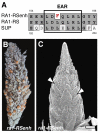The control of axillary meristem fate in the maize ramosa pathway
- PMID: 20699296
- PMCID: PMC2938917
- DOI: 10.1242/dev.051748
The control of axillary meristem fate in the maize ramosa pathway
Abstract
Plant axillary meristems are composed of highly organized, self-renewing stem cells that produce indeterminate branches or terminate in differentiated structures, such as the flowers. These opposite fates, dictated by both genetic and environmental factors, determine interspecific differences in the architecture of plants. The Cys(2)-His(2) zinc-finger transcription factor RAMOSA1 (RA1) regulates the fate of most axillary meristems during the early development of maize inflorescences, the tassel and the ear, and has been implicated in the evolution of grass architecture. Mutations in RA1 or any other known members of the ramosa pathway, RAMOSA2 and RAMOSA3, generate highly branched inflorescences. Here, we report a genetic screen for the enhancement of maize inflorescence branching and the discovery of a new regulator of meristem fate: the RAMOSA1 ENHANCER LOCUS2 (REL2) gene. rel2 mutants dramatically increase the formation of long branches in ears of both ra1 and ra2 mutants. REL2 encodes a transcriptional co-repressor similar to the TOPLESS protein of Arabidopsis, which is known to maintain apical-basal polarity during embryogenesis. REL2 is capable of rescuing the embryonic defects of the Arabidopsis topless-1 mutant, suggesting that REL2 also functions as a transcriptional co-repressor throughout development. We show by genetic and molecular analyses that REL2 physically interacts with RA1, indicating that the REL2/RA1 transcriptional repressor complex antagonizes the formation of indeterminate branches during maize inflorescence development. Our results reveal a novel mechanism for the control of meristem fate and the architecture of plants.
Figures







References
-
- Cassani E., Landoni M., Pilu R. (2006). Characterization of the Ra1 maize gene involved in inflorescence architecture. Sex. Plant Reprod. 19, 145-150
-
- Chuck G., Muszynski M., Kellogg E., Hake S., Schmidt R. J. (2002). The control of spikelet meristem identity by the branched silkless1 gene in maize. Science 298, 1238-1241 - PubMed
-
- Chuck G., Meeley R., Irish E., Sakai H., Hake S. (2007). The maize tasselseed4 microRNA controls sex determination and meristem cell fate by targeting Tasselseed6/indeterminate spikelet1. Nat. Genet. 39, 1517-1521 - PubMed
Publication types
MeSH terms
Substances
Associated data
- Actions
- Actions
Grants and funding
LinkOut - more resources
Full Text Sources

